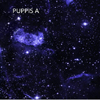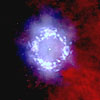CXC Home | Search | Help | Image Use Policy | Latest Images | Privacy | Accessibility | Glossary | Q&A
Images of Cosmic Cannonball
Quicktime MPEG
This sequence begins with a wide-field CTIO optical image which then combines with an X-ray image from the ROSAT observatory of Puppis A, the debris field created when a massive star exploded at the end of its life. The next image from Chandra shows the close-up view of the small, dense object, known as a "neutron star", left behind after the explosion. Chandra observations from 1999 and 2005 clearly show that the neutron star has moved over a period of five years. Astronomers calculate this neutron star is traveling at about 3 million miles per hour and is destined to exit the Galaxy million of years from now.
[Runtime: 0:12]
(Credit: Chandra: NASA/CXC/Middlebury College/F.Winkler et al.; ROSAT: NASA/GSFC/S.Snowden et al.; Optical: NOAO/AURA/NSF/Middlebury College/F.Winkler et al.)
Quicktime MPEG
This sequence begins with a wide-field CTIO optical image which then combines with an X-ray image from the ROSAT observatory of Puppis A, the debris field created when a massive star exploded at the end of its life. The next image from Chandra shows the close-up view of the small, dense object, known as a "neutron star", left behind after the explosion. Chandra observations from 1999 and 2005 clearly show that the neutron star has moved over a period of five years. Astronomers calculate this neutron star is traveling at about 3 million miles per hour and is destined to exit the Galaxy million of years from now.
[Runtime: 0:12]
(Credit: Chandra: NASA/CXC/Middlebury College/F.Winkler et al.; ROSAT: NASA/GSFC/S.Snowden et al.; Optical: NOAO/AURA/NSF/Middlebury College/F.Winkler et al.)
Animation of Supernova Explosion
Quicktime MPEG
When a massive star explodes, its outer layers are hurtled out into space at thousands of miles an hour and a neutron star is left behind. In the case of Puppis A, astronomers think the explosion that created this supernova remnant kicked the neutron star into motion, eventually ejecting this cosmic cannonball from the Milky Way galaxy.
[Runtime: 0:12]
(Credit: Credit: NASA/CXC/A.Hobart)
Quicktime MPEG
When a massive star explodes, its outer layers are hurtled out into space at thousands of miles an hour and a neutron star is left behind. In the case of Puppis A, astronomers think the explosion that created this supernova remnant kicked the neutron star into motion, eventually ejecting this cosmic cannonball from the Milky Way galaxy.
[Runtime: 0:12]
(Credit: Credit: NASA/CXC/A.Hobart)
Return to RX J0822-4300 in Puppis A (November 28, 2007)




